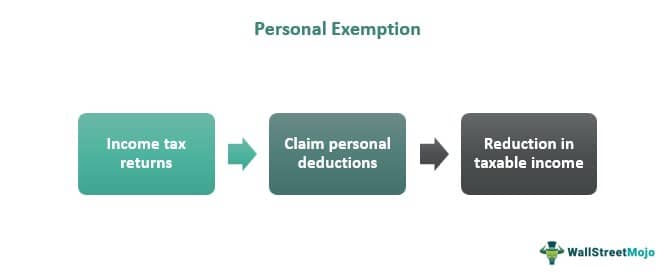Table Of Contents
What Is A Personal Exemption?
Personal exemption is a type of tax exemption that allows an individual to deduct a certain amount of money from their total income, thereby reducing their taxable income. Its purpose is to provide tax relief for individuals and their dependents.

A dependent relies on the taxpayer's financial support, and this relationship may entitle the taxpayer to certain tax benefits. Even though the personal exemption value has been reduced to zero, taxpayers eligible to claim an exemption may still qualify for other tax advantages. Previously, taxpayers could claim exemptions for themselves, their spouses, and their dependents.
Key Takeaways
- The personal exemption is a tax exemption. The money can be subtracted from a person's overall income to lower the taxable income.
- The Tax Cuts and Jobs Act suspended (reduced to $0) the personal exemption deduction for tax years 2018 through 2025.
- Even though a spouse is not a dependent, if an individual is married and filing a joint tax return, they may claim one exemption for their spouse.
- The exemption has a phaseout for higher-income people because it is intended to help those with lower incomes.
Personal Exemption Explained
The personal exemption, spousal (married), and dependent exemptions protect a certain base income from taxation. When the first income tax was collected in 1913, the personal exemption was set at $3,000, as only a small percentage of people earned enough income to owe taxes. The current exemption aims to achieve the same goal.
Before 2018, every taxpayer was eligible for a fixed exemption that could be used to reduce their taxable income for themselves, their spouse, and any qualifying dependents. The exemption amount was the same for everyone and adjusted for inflation, with a value of $4,050 per person in 2017. If no changes are made to the current law (as of 2022), the personal exemption will be reinstated beginning in 2026 after being suspended from 2018 through 2025. From 1991 to 2017, except for three years (2010-2012), the exemption value gradually decreased for taxpayers whose income exceeded a certain threshold.
The exemption is phased out for higher-income individuals, as it is intended to assist those with lower incomes. If a single filer's adjusted gross income (AGI) exceeds $254,200, their exemption is reduced by 2% for every $2,500 of income over the threshold. The IRS states that the personal exemption for taxes is eliminated (reduced to zero) once the AGI reaches $376,700. (The AGI is the remaining amount of gross income after certain expenses like student loan interest or alimony are deducted).
The Tax Cuts and Jobs Act has suspended the personal exemption deduction for tax years 2018 through 2025, effectively reducing it to $0.
How To Claim?
Before the 2018 tax year, to claim a personal exemption on their federal tax return, the taxpayer would have needed to:
- Determine eligibility: The taxpayer could claim a personal exemption for themselves if no one else could claim them as a dependent on their tax return. The taxpayer could also claim a personal exemption for their dependents who met certain criteria.
- Gather the necessary information: The taxpayer must provide the name, Social Security Number, and details of the relationship with the dependent, such as whether they were the taxpayer's child or another relative who lived with them for more than half the year. The taxpayer may have also needed to provide their dependents' birth dates.
- Complete the appropriate tax forms: The taxpayer would have needed to complete the appropriate forms, such as Form 1040 or Form 1040A, and indicate the number of personal exemptions they claimed.
- File their tax return: The taxpayer must file their tax return and include any documentation required to support their claim for personal exemptions.
It's important to note that the rules for claiming personal exemptions may vary depending on the tax year and individual circumstances.
Examples
Example #1
Randy has a monthly income of $5000, totaling $60,000 yearly. He has a dependent spouse; they are married and filing separately, and they are supposed to file his tax returns for 2022. Since it is 2022 and personal exemption on taxes is temporarily suspended, he cannot claim deductions. However, he could take a standard deduction of $12,950 and other deductions to reduce his taxable income.
Example #2
Under the previous tax code, Jay has a family of four with one married couple and two dependent children for whom he could claim exemptions. They are students ages 15 and 20. The amount, which equals $16,200 (4050 * 4) in deductions for both, automatically deducts from their taxable income.
Personal Exemption vs Standard Deduction
| Key Points | Personal Exemption | Standard Deduction |
|---|---|---|
| 1. Meaning | According to US tax law, a personal exemption is a sum a resident taxpayer can deduct from personal income. It determines their taxable income and, subsequently, their federal income tax. | The IRS grants individuals a set amount known as a "standard deduction" that they can use to lower their taxes based on their filing status. In addition, the IRS allows taxpayers to choose between the applicable standard deduction and their itemized deductions. |
| 2. Details required | Deduction requires details such as the Individual's name, spouse's name, mailing address, date of birth, job title, spouse's title, etc. | Deduction requires details such as whether they are 65 or older or blind and whether they can be claimed as a dependent. |
| 3. Deduction | Before the law curtailed it, $4,050 was the personal exemption amount for 2017. | 2023 Standard Deductions: Single and Married Filing Separately amounts to $13,850, Married Filing Joint and Qualifying Widow(er) amounts to $27,700, and Head of Household amounts to $20,800. |
